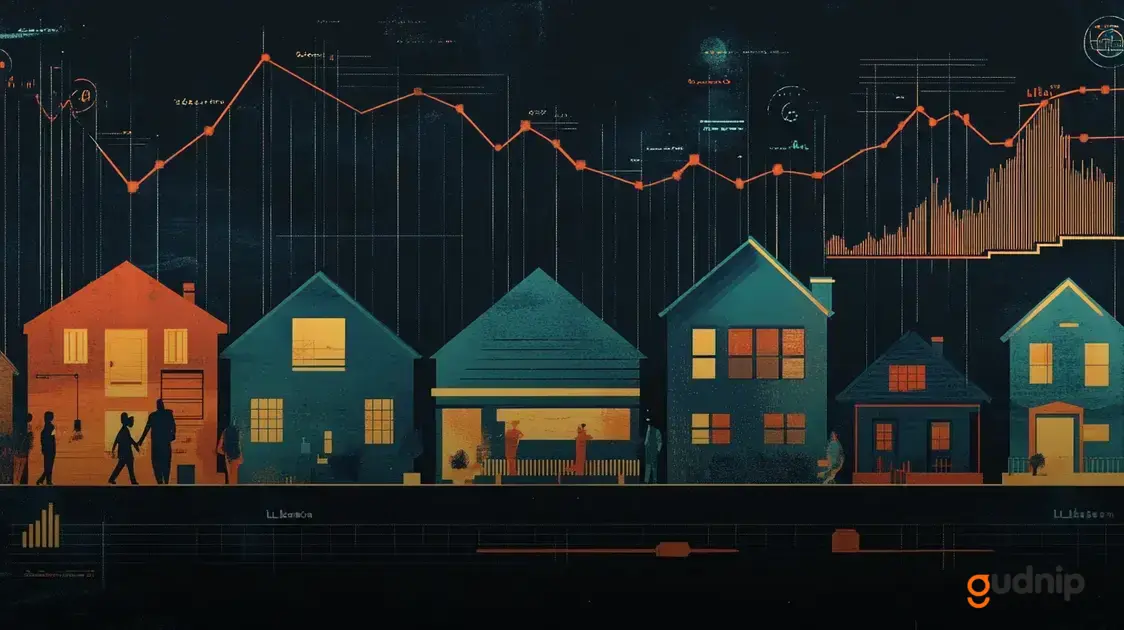Mortgage interest rates are influenced by economic conditions, inflation, and Federal Reserve policies.
To secure the best mortgage, shop around, compare rates, and consider locking in a rate when favorable.
Understanding regional variations and long-term projections aids homebuyers in making informed decisions.
Mortgage interest rates forecast plays a crucial role in determining your home buying strategy.
As we approach 2024, understanding these trends becomes vital for potential homeowners and real estate investors alike.
Fluctuating rates can significantly affect affordability and overall purchasing power in today’s dynamic market.
Understanding Mortgage Interest Rates
Understanding mortgage interest rates is crucial for anyone looking to buy a home.
These rates determine how much you will pay your lender for the loan you receive to purchase your property.
Generally, mortgage interest rates are influenced by a variety of factors, including economic conditions, inflation, and the central bank’s monetary policy.
What are Mortgage Interest Rates?
Mortgage interest rates represent the cost of borrowing money for your home.
When you take out a mortgage, you agree to pay back the loan with interest over a specified period, typically 15 to 30 years.
The interest rate affects your monthly payment and the total cost of your home.
Types of Mortgage Interest Rates
There are two main types of mortgage interest rates:
- Fixed-rate mortgages: These loans have a consistent interest rate for the life of the loan. This means your monthly payment will remain constant, providing stability and predictability.
- Adjustable-rate mortgages (ARMs): With ARMs, the interest rate may change over time based on market conditions. This can result in lower initial payments, but it also means your monthly payments could increase in the future.
Current Trends in Mortgage Rates
Mortgage interest rates fluctuate based on the economy. When the economy is strong and inflation rates rise, you can expect higher mortgage rates.
Conversely, during economic downturns, rates often decrease to stimulate borrowing and spending.
Keeping an eye on these trends can help you make informed decisions about your mortgage.
Why Understanding Rates is Important
Knowing how mortgage interest rates work allows you to budget effectively and choose the right loan for your needs.
It can also help you decide the best time to buy a home or refinance your existing mortgage.
Factors Influencing Rates
Several factors influence mortgage interest rates. Understanding these factors can help you anticipate changes and make better financing decisions.
Economic Conditions
The overall health of the economy is a major influencer of mortgage rates. When the economy is strong, rates tend to rise.
Conversely, when the economy weakens, rates often decrease. This is because lenders charge more during times of growth due to increased demand for loans.
Inflation
Inflation is another critical factor that impacts mortgage rates. As inflation rises, the purchasing power of money decreases.
To counteract this, lenders often increase interest rates to maintain their profit margins. Higher inflation can lead to higher mortgage rates.
Federal Reserve Policies
The Federal Reserve plays a significant role in determining interest rates.
When the Fed raises or lowers the federal funds rate, it influences the rates banks charge for loans, including mortgages.
A rate hike usually leads to higher mortgage rates, while a rate cut can result in lower rates.
Credit Score
Your credit score also affects the mortgage rates you may qualify for. Lenders view higher credit scores as less risky, which can lead to lower interest rates.
Conversely, lower credit scores can result in higher rates due to the perceived risk.
Loan Type and Term
Different loan types and terms can have varying interest rates. Fixed-rate mortgages typically have higher rates than adjustable-rate mortgages in the beginning.
However, ARMs can adjust up after a certain period, potentially leading to higher costs over time.
Down Payment
The size of your down payment can also influence your interest rate.
Generally, a larger down payment can lead to a lower mortgage rate, as it reduces the lender’s risk.
Conversely, putting down a smaller amount may result in higher rates and additional private mortgage insurance (PMI).
Historical Trends in Mortgage Rates

Historical trends in mortgage rates provide valuable insights into how these rates have changed over time.
Understanding these trends can help you make informed decisions about borrowing and investing in real estate.
Long-Term Trends
Looking back over the past few decades, mortgage rates have experienced significant fluctuations.
In the 1980s, rates soared to all-time highs, often reaching over 18%.
This surge was due to a combination of high inflation and economic instability.
Declining Rates in the 1990s
As the economy stabilized, mortgage rates began to decline throughout the 1990s. By the end of the decade, rates had dropped into the range of 7% to 8%.
This made home buying more accessible for many families and led to a booming housing market.
Early 2000s and Housing Bubble
In the early 2000s, mortgage rates continued to decrease, reaching historic lows around 5%.
This period, coupled with favorable lending practices, contributed to the housing bubble that eventually burst in 2007.
The rapid increase in home values was not sustainable.
After the Crisis
Following the 2008 financial crisis, the Federal Reserve implemented policies to keep interest rates low to stimulate the economy.
Mortgage rates fell to unprecedented lows, often dipping below 3% for 30-year fixed-rate mortgages by 2020.
Recent Trends
As of 2023, we’ve seen a gradual increase in mortgage rates due to rising inflation and adjustments by the Federal Reserve.
Rates have crept back into the higher range, affecting affordability and buyer demand.
Implications for Homebuyers
By understanding these historical trends, potential homebuyers can better gauge the current market.
Knowing when to buy or refinance can make a significant difference in overall costs and affordability.
Predictions for 2024
As we look ahead to 2024, many experts are making predictions about mortgage interest rates.
These forecasts depend on various factors, including economic conditions and decisions made by the Federal Reserve.
Potential Rate Increases
Analysts predict that mortgage rates could continue to rise in 2024. This expectation is largely due to ongoing inflation concerns and an economy that remains volatile.
If the Federal Reserve continues to increase interest rates to combat inflation, mortgage rates are likely to follow.
Impact of the Federal Reserve
The Federal Reserve has a significant influence on mortgage rates. If the Fed raises the federal funds rate several times in 2024, lenders may respond by increasing mortgage rates.
Homebuyers should be prepared for the possibility of higher borrowing costs throughout the year.
Regional Variations
It is important to note that mortgage rates may vary regionally.
Areas experiencing high demand for housing may see more significant rate increases compared to regions with weaker housing markets.
Understanding local market conditions can help potential buyers make better decisions.
Market Competitiveness
Competition among lenders can also impact mortgage rates.
In 2024, if lenders continue to compete aggressively for borrowers, this could help keep rates lower than anticipated.
Homebuyers should shop around to find the best rates and loan terms.
Advice for Homebuyers
For those considering purchasing a home in 2024, it may be wise to lock in a mortgage rate sooner rather than later.
Waiting for rates to drop may not be a reliable strategy, given the potential for sustained increases.
Impact of Federal Reserve Decisions
The Federal Reserve plays a key role in shaping mortgage interest rates.
Its decisions regarding monetary policy directly affect the economy, which in turn influences borrowing costs for consumers.
Federal Funds Rate
The federal funds rate is the interest rate at which banks lend money to one another overnight.
When the Federal Reserve raises this rate, it typically leads to higher borrowing costs for consumers, including mortgage rates.
This can result in a ripple effect throughout the economy.
Rate Hikes and Their Effects
When the Fed increases interest rates, potential homebuyers may face higher mortgage rates. This makes it more expensive to borrow money for a home.
As a result, demand for housing may decrease as fewer buyers can afford higher payments.
Monetary Policy Changes
Conversely, when the Federal Reserve lowers interest rates, mortgage rates usually decrease as well.
This can stimulate the housing market as buyers find it easier to obtain loans and pay lower monthly costs.
Long-Term Projections
The expectations of future Federal Reserve actions can also impact mortgage rates.
If investors anticipate future rate hikes, mortgage rates may rise in advance as lenders adjust their pricing strategies.
Economic Indicators
The decisions made by the Fed are based on various economic indicators, such as inflation and employment rates.
Strong economic growth can lead to rate increases, while weaker growth may prompt the Fed to lower rates, keeping mortgage costs favorable for buyers.
Regional Variations in Rates

Regional variations in mortgage rates highlight the differences in borrowing costs across different parts of the country.
Understanding these differences is crucial for potential homebuyers and investors.
Why Do Rates Vary by Region?
Mortgage rates can differ greatly depending on regional factors. These factors include local demand for housing, economic conditions, and housing supply.
Areas with high demand and limited housing options often experience higher rates.
Urban vs. Rural Areas
Urban areas generally have higher mortgage rates compared to rural regions. This is due to stronger demand for housing in cities, where more people want to live.
In contrast, rural areas may have lower demand, leading to more competitive rates.
State Regulations and Taxes
State laws and regulations also influence mortgage rates.
Some states have lower property taxes or fewer fees associated with mortgage loans, making borrowing more affordable.
Understanding the local market can help buyers identify the best financing options.
Economic Conditions
The economic situation in a region impacts mortgage rates. States with strong job growth and a healthy economy often see higher rates due to increased demand for housing.
Areas experiencing economic decline may have lower rates as lenders seek to stimulate borrowing.
Market Competition
Lastly, competition among lenders in a region affects mortgage rates. In competitive markets, lenders may lower rates to attract customers.
Homebuyers should compare offers from multiple lenders to find the best deals in their region.
Effects of Inflation on Rates
The effects of inflation on mortgage rates are significant and can influence buying power for homebuyers.
When inflation rises, it affects various aspects of the economy, including interest rates.
Understanding Inflation
Inflation is the rate at which the general level of prices for goods and services rises. As prices increase, the purchasing power of money decreases.
This means that consumers can buy fewer goods and services with the same amount of money.
Inflation and Mortgage Rates
When inflation rises, lenders typically respond by increasing mortgage rates. This is because lenders want to maintain their profit margins.
If inflation is high, the money they receive in the future will be worth less. Therefore, they raise rates to account for the decrease in value.
Impact on Borrowing Costs
Higher mortgage rates resulting from inflation can significantly impact home affordability.
As rates increase, monthly payments become more expensive, making it harder for buyers to qualify for loans and purchase homes.
Future Expectations
If inflation continues to rise in 2024, we can expect mortgage rates to increase as well.
Homebuyers should be mindful of these trends when planning their purchases and consider locking in rates if they are currently low.
Adapting to Changes
Understanding the relationship between inflation and mortgage rates helps potential buyers make informed decisions.
Homebuyers may want to act sooner rather than later to avoid higher costs.
Tips for Locking in Rates
Locking in a mortgage rate can save you money and provide financial security. Here are some important tips to consider when looking to lock in your rate.
1. Understand Rate Lock Terms
Before you lock in a rate, be sure to understand the terms associated with it.
Some lenders offer fixed-rate locks for a specific number of days, while others may have different policies. Knowing the terms can prevent surprises later.
2. Monitor Market Trends
Keep an eye on mortgage rate trends. If rates are currently low, it may be a good time to lock in your rate.
Use reliable financial news sources to stay updated on market conditions.
3. Communicate with Your Lender
It’s essential to maintain open communication with your lender. Ask them about their rate lock options and any associated fees.
They can guide you on the best time to lock in your desired rate based on current market conditions.
4. Act Quickly
Once you see a rate you are happy with, consider locking it in quickly.
Rates can fluctuate frequently, so timing is key. Delaying could result in missing out on a lower rate.
5. Consider a Longer Lock Period
If you’re concerned about potential rate increases in the near future, ask your lender about locking in a longer-term rate.
While this may come with a cost, it can provide peace of mind.
6. Document Everything
Keep a record of your rate lock confirmation. This includes the lock date, the locked rate, and any terms discussed with your lender.
Having documentation can help if any issues arise later.
How to Shop for the Best Mortgage

Shopping for the best mortgage is a crucial step for anyone looking to buy a home. Here are some effective tips to help you navigate this process.
1. Know Your Budget
Before you start shopping for mortgages, determine how much you can afford.
Take a close look at your finances, including your income, expenses, and savings. This will help you set a realistic budget.
2. Research Different Lenders
There are many lenders available, including banks, credit unions, and online mortgage companies.
Research different options to find the ones that best suit your needs. Check their reviews and compare services.
3. Compare Mortgage Rates
When you find potential lenders, compare their mortgage rates. Even a small difference in rates can lead to significant savings over time.
Make sure to look at the annual percentage rate (APR) as well, which includes fees.
4. Understand Loan Types
Familiarize yourself with different types of mortgages, such as fixed-rate, adjustable-rate, and government-backed loans.
Each type has its benefits and drawbacks, so choose the one that aligns with your financial goals.
5. Get Pre-Approved
Consider getting pre-approved for a mortgage. This process can give you a clear idea of how much you can borrow and shows sellers that you are a serious buyer.
The pre-approval letter will specify your loan amount and terms.
6. Ask About Fees
Inquire about any additional fees lenders may charge, such as application fees, appraisal fees, and closing costs.
Understanding these costs will give you a more accurate picture of the total amount you’ll need for your mortgage.
7. Read the Fine Print
Before signing a mortgage agreement, carefully review the terms and conditions.
Pay attention to the fine print, as it may include important details about fees, penalties, and rate adjustments.
Long-Term Projections for Homebuyers
When considering long-term projections for homebuyers, it is important to factor in various aspects that will impact the housing market and mortgage rates over the years.
Understanding these elements can prepare buyers for what lies ahead.
1. Interest Rate Trends
Over the next few years, it is expected that mortgage rates will remain a significant factor for homebuyers.
As the Federal Reserve adjusts interest rates to combat inflation, mortgage rates may continue to fluctuate.
Homebuyers should keep an eye on these trends to make informed decisions about when to buy.
2. Housing Market Demand
Demand for housing is projected to remain strong in many urban areas, driven by factors such as population growth and job opportunities.
This increase in demand can lead to rising home prices. Buyers should consider acting sooner rather than later to avoid paying higher prices in the future.
3. Economic Conditions
The overall economy will play a crucial role in shaping the housing market.
If economic growth continues, this may support higher wages and improved job security, making homeownership more accessible.
However, economic downturns could negatively affect buyer confidence and demand.
4. Technological Advances
Technological advances in the real estate industry are likely to change how homebuyers search for properties and secure financing.
Online tools and platforms may simplify the mortgage application process, making it easier for buyers to find and finance their dream homes.
5. Demographic Shifts
Demographic trends, such as millennials entering the housing market, will also influence long-term projections.
As more young people seek to buy homes, the types of properties in demand may shift, influencing pricing and inventory.
6. Government Policies
Changes in government policies related to housing and mortgages can create a different landscape for buyers.
Homebuyer assistance programs or tax incentives may affect the market by encouraging or discouraging home ownership.
FAQ – Frequently Asked Questions About Mortgage Interest Rates
What affects mortgage interest rates?
Mortgage interest rates are primarily affected by economic conditions, inflation, Federal Reserve policies, and supply and demand in the housing market.
How can I lock in a mortgage rate?
You can lock in a mortgage rate by formally agreeing with your lender on a specific rate for a set period, which protects you from rate increases while you finalize your loan.
When is the best time to buy a home?
The best time to buy a home varies; however, many experts recommend purchasing when rates are low to maximize your purchasing power and minimize monthly payments.
How can I shop for the best mortgage?
To shop for the best mortgage, compare rates from multiple lenders, understand different loan types, and check for additional fees and closing costs.
What are the long-term projections for homebuyers?
Long-term projections suggest that mortgage rates may rise, housing demand will remain strong, and demographic shifts will continue to influence market conditions.
How does inflation impact mortgage rates?
When inflation rises, lenders often increase mortgage rates to maintain their profit margins, which can result in higher borrowing costs for homebuyers.





